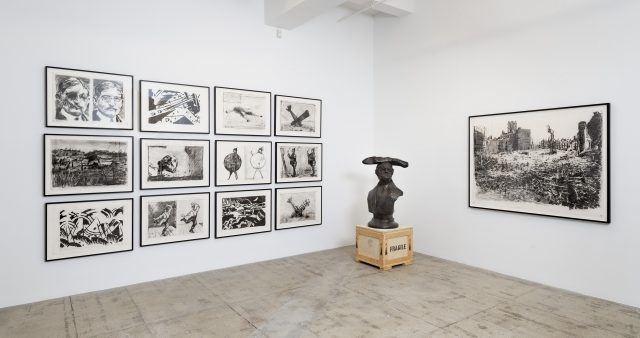
William Kentridge’s “Let Us Try for Once” in infused with the spirit of Dada (photo courtesy Marian Goodman Gallery)
Marian Goodman Gallery
24 West 57th St. between Fifth & Sixth Aves.
Tuesday – Saturday through April 20, free
212-977-7160
www.mariangoodman.com
In 2017, South African multimedia genius William Kentridge staged Kurt Schwitters’s 1932 Dada poem, “Ursonate,” at the Harlem Parish as part of the Performa Biennial. In December, his extraordinary production The Head & the Load, which explored the fate of nearly two million black Africans forced into service by colonialist European countries as porters and carriers during World War I, also incorporated text from “Ursonate.” Kentridge turns to Dada again for the title of his latest exhibition at Marian Goodman, “Let Us Try for Once,” taken from the last sentence of Tristan Tzara’s 1919 Dada Manifesto: “If all of them are right and if all pills are Pink Pills, let us try for once not to be right.” In a promotional video, Kentridge notes that the title “comes out of the sense that everybody’s certainty of their own rightness is behind so much of the violence which is exacted to beat that sense of rightness into others.”
The show is divided into four sections across two floors. In a back room, a two-channel video of Kentridge’s inspired performance of “Ursonate” plays, featuring such language as “rakete rinnzekete,” “fümmsböwötääzääUu pöggiff,” and “rrummpff tillff toooo?” along with visuals and, at the end, musical accompaniment. KABOOM! is a three-channel sculptural installation that is a miniaturized version of The Head & the Load, with audio, video, drawings, and projections. “This was not its starting point of The Head & the Load, but it is what the work itself, the material we were dealing with, pushed us towards,” Kentridge explains in a statement. “By the paradox I mean the contradictory relationships towards Europe — the desire of Africans to be part of Europe, to share in the wealth and the richness of Europe, and wanting to resist Europe and its depredations.”
(photo by twi-ny/mdr)
Lexicon is a collection of large bronze sculptures that Kentridge compares to text in a book, representing “the heaviness of words or thoughts,” including a telephone, an ampersand, a movie camera, a knight on a horse, and a pitcher; Processione di Riparazioniste Maquettes (Full Set) is a horizontal procession of smaller laser-cut steel objects, while Paragraph II, three rows of twenty-three bronzes, evokes black type on a white page. In fact, many of these pieces have appeared as images in Kentridge’s videos in which he turns the pages of dictionaries and historical books.

William Kentridge, Drawing for Wozzeck Opera, charcoal on paper, 2017 (courtesy Marian Goodman)
The exhibition also offers a sneak peek of his latest opera, Alban Berg’s Wozzeck, which is coming to the Met in December. Kentridge has previously adapted Shostakovich’s The Nose and Berg’s Lulu; at Marian Goodman, preparatory charcoal drawings give a sense of the flavor of his take of Berg’s version of Georg Büchner’s unfinished Woyceck and continues Kentridge’s exploration of the Great War. “The conceit of the production was thinking of Berg’s Wozzeck as a premonition of WWI. This is where war and ideas around it entered the project,” Kentridge notes. “Let Us Try for Once” lends fascinating insight into the recent past, present, and immediate future of this marvelously talented artist.